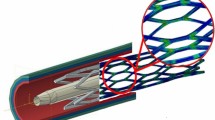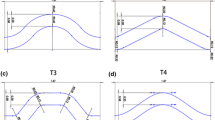Abstract
Biodegradable magnesium alloy stents (MAS) are a promising solution for long-term adverse events caused by interactions between vessels and permanent stent platforms of drug eluting stents. However, the existing MAS showed severe lumen loss after a few months: too short degradation time may be the main reason for this drawback. In this study, a new design concept of MAS was proposed and a shape optimization method with finite element analysis was applied on two-dimensional (2D) stent models considering four different magnesium alloys: AZ80, AZ31, ZM21, and WE43. A morphing procedure was utilized to facilitate the optimization. Two experiments were carried out for a preliminary validation of the 2D models with good results. The optimized designs were compared to an existing MAS by means of three-dimensional finite element analysis. The results showed that the final optimized design with alloy WE43, compared to the existing MAS, has an increased strut width by approximately 48%, improved safety properties (decreased the maximum principal stress after recoil with tissue by 29%, and decreased the maximum principal strain during expansion by 14%) and improved scaffolding ability (increased by 24%). Accordingly, the degradation time can be expected to extend. The used methodology provides a convenient and practical way to develop novel MAS designs.











Similar content being viewed by others
References
Capelli, C., F. Gervaso, L. Petrini, G. Dubini, and F. Migliavacca. Assessment of tissue prolapse after balloon-expandable stenting: influence of stent cell geometry. Med. Eng. Phys. 31:441–447, 2009.
Dalla Torre, F. H., A. C. Hanzi, and P. J. Uggowitzer. Microstructure and mechanical properties of microalloyed and equal channel angular extruded Mg alloys. Scripta Mater. 59:207–210, 2008.
De Beule, M., P. Mortier, S. G. Carlier, B. Verhegghe, R. Van Impe, and P. Verdonck. Realistic finite element-based stent design: the impact of balloon folding. J. Biomech. 41:383–389, 2008.
Donnelly, E. W., M. S. Bruzzi, T. Connolley, and P. E. McHugh. Finite element comparison of performance related characteristics of balloon expandable stents. Comput. Methods Biomech. Biomed. Eng. 10:103–110, 2007.
Erbel, R., C. Di Mario, J. Bartunek, J. Bonnier, B. de Bruyne, F. R. Eberli, P. Erne, M. Haude, B. Heublein, M. Horrigan, C. Ilsley, D. Bose, J. Koolen, T. F. Luscher, N. Weissman, R. Waksman, and P.-A. Investigators. Temporary scaffolding of coronary arteries with bioabsorbable magnesium stents: a prospective, non-randomised multicentre trial. Lancet 369:1869–1875, 2007.
Gervaso, F., C. Capelli, L. Petrini, S. Lattanzio, L. Di Virgilio, and F. Migliavacca. On the effects of different strategies in modelling balloon-expandable stenting by means of finite element method. J. Biomech. 41:1206–1212, 2008.
Gu, X. N., Y. F. Zheng, Y. Cheng, S. P. Zhong, and T. F. Xi. In vitro corrosion and biocompatibility of binary magnesium alloys. Biomaterials 30:484–498, 2009.
Kastrati, A., J. Mehilli, J. Dirschinger, F. Dotzer, H. Schühlen, F. J. Neumann, M. Fleckenstein, C. Pfafferott, M. Seyfarth, and A. Schömig. Intracoronary stenting and angiographic results: strut thickness effect on restenosis outcome (ISAR-STEREO) trail. Circulation 103:2816–2821, 2001.
Kiousis, D., A. Wulff, and G. Holzapfel. Experimental studies and numerical analysis of the inflation and interaction of vascular balloon catheter-stent systems. Ann. Biomed. Eng. 37:315–330, 2009.
Lally, C., F. Dolan, and P. J. Prendergast. Cardiovascular stent design and vessel stresses: a finite element analysis. J. Biomech. 38:1574–1581, 2005.
Li, N., H. W. Zhang, and H. J. Ouyang. Shape optimization of coronary artery stent based on a parametric model. Finite Elem. Anal. Des. 45:468–475, 2009.
Marry, V. R., R. Burgermeister, R. B. Grishaber, and R. O. Ritchie. Fatigue and life prediction for cobalt-chromium stents: a fracture mechanics analysis. Biomaterials 27:1988–2000, 2006.
McGarry, J. P., B. P. O’Donnell, P. E. McHugh, and J. G. McGarry. Analysis of the mechanical performance of a cardiovascular stent design based on micromechanical modelling. Comp. Mater. Sci. 31:421–438, 2004.
Mori, K., and T. Saito. Effects of stent structure on stent flexibility measurements. Ann. Biomed. Eng. 33:733–742, 2005.
Muller, H. Development of matellic bioabsorbable intravascular implants. In: New Technologies in Vascular Biomaterials. Connecting Biomaterials to Arterial Structures, edited by N. Chakfé, and B. Durand. Strasbourg: Europrot, 2009, pp. 23–32.
Peeters, P., M. Bosiers, J. Verbist, K. Deloose, and B. Heublein. Preliminary results after application of absorbable metal stents in patients with critical limb ischemia. J. Endovasc. Ther. 12:1–5, 2005.
Pelton, A. R., V. Schroeder, M. R. Mitchell, X. Y. Gong, M. Barney, and S. W. Robertson. Fatigue and durability of Nitinol stents. J. Mech. Behav. Biomed. Mater. 1:153–164, 2008.
Pericevic, I., C. Lally, D. Toner, and D. J. Kelly. The influence of plaque composition on underlying arterial wall stress during stent expansion: the case for lesion-specific stents. Med. Eng. Phys. 31:428–433, 2009.
Petrini, L., F. Migliavacca, F. Auricchio, and G. Dubini. Numerical investigation of the intravascular coronary stent flexibility. J. Biomech. 37:495–501, 2004.
Rizvi, N. H. Femtosecond laser micromachining: current status and applications. RIKEN Rev. 50:107–112, 2003.
Schranz, D., P. Zartner, I. Michel-Behnke, and H. Akinturk. Bioabsorbable metal stents for percutaneous treatment of critical recoarctation of the aorta in a newborn. Catheter. Cardio. Inte. 67:671–673, 2006.
Slottow, T. L. P., R. Pakala, and R. Waksman. Serial imaging and histology illustrating the degradation of a bioabsorbable magnesium stent in a porcine coronary artery. Eur. Heart J. 29:314, 2008.
Timmins, L. H., M. R. Moreno, C. A. Meyer, J. C. Criscione, A. Rachev, and J. E. Moore. Stented artery biomechanics and device design optimization. Med. Biol. Eng. Comput. 45:505–513, 2007.
Tsimikas, S. Drug-eluting stents and late adverse clinical outcomes—lessons learned, lessons awaited. J. Am. Coll. Cardiol. 47:2112–2115, 2006.
Waksman, R. Promise and challenges of bioabsorbable stents. Catheter. Cardio. Inte. 70:407–414, 2007.
Waksman, R., R. Pakala, P. K. Kuchulakanti, R. Baffour, D. Hellinga, R. Seabron, F. O. Tio, E. Wittchow, S. Hartwig, C. Harder, R. Rohde, B. Heublein, A. Andreae, K. H. Waldmann, and A. Haverich. Safety and efficacy of bioabsorbable magnesium alloy stents in porcine coronary arteries. Catheter. Cardio. Inte. 68:607–617, 2006.
Wang, G. G., Z. M. Dong, and P. Aitchison. Adaptive response surface method—a global optimization scheme for approximation-based design problems. Eng. Optimiz. 33:707–733, 2001.
Winzer, N., A. Atrens, W. Dietzel, G. Song, and K. U. Kainer. Stress corrosion cracking in magnesium alloys: characterization and prevention. JOM 59:49–53, 2007.
Wu, W., M. Qi, X. P. Liu, D. Z. Yang, and W. Q. Wang. Delivery and release of nitinol stent in carotid artery and their interactions: a finite element analysis. J. Biomech. 40:3034–3040, 2007.
Wu, W., D. Z. Yang, Y. Y. Huang, M. Qi, and W. Q. Wang. Topology optimization of a novel stent platform with drug reservoirs. Med. Eng. Phys. 30:1177–1185, 2008.
Acknowledgments
The research is supported by a grant from the Fondazione Cassa di Risparmio di Trento e Rovereto, the financial support of the IIT through the project ‘Models and Methods for Degradable Materials’ and the financial support of the Politecnico di Milano through the project ‘Development of bioabsorbable magnesium alloy innovative stents’.
Author information
Authors and Affiliations
Corresponding author
Additional information
Associate Editor Jane Grande-Allen oversaw the review of this article.
Rights and permissions
About this article
Cite this article
Wu, W., Petrini, L., Gastaldi, D. et al. Finite Element Shape Optimization for Biodegradable Magnesium Alloy Stents. Ann Biomed Eng 38, 2829–2840 (2010). https://doi.org/10.1007/s10439-010-0057-8
Received:
Accepted:
Published:
Issue Date:
DOI: https://doi.org/10.1007/s10439-010-0057-8




